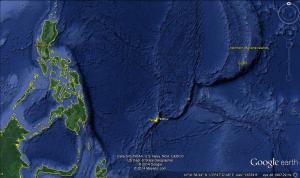On 15 September 1944, American forces landed on the shores of a tiny spit of lobster-claw-shaped coral rock in the western Pacific named Peleliu. The landing was spearheaded by the 1st Marine Division of the United States Marine Corps under MajGen. William Rupertus, as the U.S. pushed forward in its island hopping campaign against the forces of Imperial Japan. The 11,000 Japanese defenders of the 14th Infantry Division under Col. Kunio Nakagawa were well-fortified in the ridges of the island’s center. They exercised effective fire discipline in order to prevent their positions from being discovered, and planned out interlocking defensive positions with fields of fire covering almost every part of the island.
Eugene B. Sledge was a mortar man with Company K, 3d Battalion, 5th Marine Regiment during the landing and subsequent battle across Peleliu. In his 1981 memoir With The Old Breed At Peleliu And Okinawa, Sledge leaves us with a haunting description of the terrifying effect that Japanese artillery had on the attacking Americans.
There was nothing subtle or intimate about the approach and explosion of an artillery shell. When I heard the whistle of an approaching one in the distance, every muscle in my body contracted. I braced myself in a puny effort to keep from being swept away. I felt utterly helpless.
As the fiendish whistle grew louder, my teeth ground against each other, my heart pounded, my mouth dried, my eyes narrowed, sweat poured over me, my breath came in short irregular gasps, and I was afraid to swallow lest I choke. I always prayed, sometimes out loud.
Under certain conditions of range and terrain, I could hear the shell approaching from a considerable distance, thus prolonging the suspense into seemingly unending torture. At the instant the voice of the shell grew the loudest, it terminated in a flash and a deafening explosion similar to the crash of aloud clap of thunder. The ground shook and the concussion hurt my ears. Shell fragments tore the air apart as they rushed out, whirring and ripping. Rocks and dirt clattered onto the deck as smoke of the exploded shell dissipated.
To be under a barrage or prolonged shelling simply magnified all the terrible physical and emotional effects of one shell. To me, artillery was an invention of hell. The onrushing whistle and scream of the big steel package of destruction was the pinnacle of violent fury and the embodiment of pent-up evil. It was the essence of violence and of man’s inhumanity to man. I developed a passionate hatred for shells. To be killed by a bullet seemed so clean and surgical. But shells would not only tear and rip the body, they tortured one’s mind almost beyond the brink of sanity.
MajGen. Rupertus had predicted the island would be secured in four days. The effectiveness of the Japanese defense dragged the battle out for two months. By the end of November, the Americans had suffered more than 8,000 casualties, including more than 1,500 killed in action. Nearly all the Japanese soldiers died defending the island, and the Imperial Japanese Army’s 14th Infantry Division effectively ceased to exist. Peleliu was targeted by the Americans in order to use the airfield and to protect the eastern flank of the planned assault on the Philippines. However, the island ended up being of limited value as U.S. forces moved to re-take the Philippines.

